The Tech Behind Red Bull Stratos And The Death-Defying Leap From The Edge Of Space
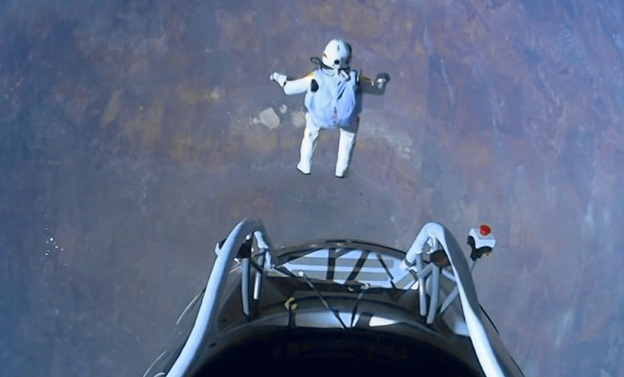
Sixty-five years to the day since Captain Charles Yeager became the first man to travel past the speed of sound, Felix Baumgartner yesterday became the only living man to ever break the sound barrier without a spacecraft. Logistically, the Red Bull Stratos mission is a feat in of itself, though it’s the technology behind it that made this particular jump so fascinating.
It was a death-defying ‘stunt’ that grabbed the world’s attention – the event became the most-watched live event on YouTube ever, attracting over 8m viewers – which involved a specially-made helium balloon carrying Austrian Felix Baumgartner to an altitude of 128,000 feet (39km) above New Mexico and Earth at around 1,000 feet per minute. Levelling off at a height several times higher than the altitude of commercial airlines, and higher still than the ‘world altitude record’ of jet aircraft at 123,520 feet, the world watched as the door of the pressurised capsule opened and Baumgartner looked to the Earth below.
Displaying a mix of traits somewhere between courage, tenacity, showmanship, determination and downright craziness, Baumgartner jumped. The 43-year-old went on to break the record for highest manned balloon flight, achieved the fastest freefall after reaching a speed nudging 834mph (1,342km/h) and broke the sound barrier, according to mission spokeswoman Sarah Anderson.
But what of the technology behind the jump? Years in the planning, the Red Bull Stratos mission is one fraught with a very real danger of death, one extraordinarily ambitious to achieve, but also one with a spectacle quite unlike any other. Here’s how they achieved the feat.
The Space Suit
Having to protect Baumgartner from temperatures approaching -90° Fahrenheit, capable of monitoring and maintaining its own pressure automatically at various altitudes, and with a variety of enhancements including mirrors and added mobility to aid motion and grant fuller peripheral vision, Felix's full-pressure space suit is a remarkable piece of kit.
It's his personal life support system, not only preventing Baumgartner's blood turning to gas and expanding (a condition called ebullism) as an atmospheric pressure of 0.067 PSIA and a virtual vacuum surrounds him, but one that includes all the safety features you'd expect for such a tremendous leap; 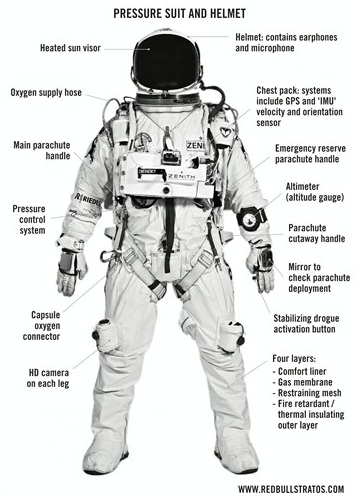 including a fail-safe 'drogue' parachute that would have deployed automatically if Felix entered an uncontrolled spin beyond the 6.5 G force threshold for more than six seconds.
including a fail-safe 'drogue' parachute that would have deployed automatically if Felix entered an uncontrolled spin beyond the 6.5 G force threshold for more than six seconds.
It also delivered one hundred per-cent oxygen to Baumgartner to breathe from various sources throughout the build-up, ascent and descent. Switching between them dependent on the stage of the mission; oxygen was delivered in a liquefied state while on ground and then inside the capsule, before a pair of high-pressure gaseous oxygen cylinders took over during the freefall.
Meanwhile, the chest pack worn by Felix is chock-full of high-tech gadgetry and gizmos, including GPS beacons; telemetry equipment; an inertia measurement unit (IMU) that measures altitude, orientation and gravitational forces; a HD camera with a 120-degree view and a tech package that the world governing body for air sports and aeronautical world records use to verify the various records.
A microphone and earphones within the helmet ensured Baumgartner was able to keep in contact with Mission Control in Roswell throughout. Not bad considering he was travelling at speeds averaging 700mph for a majority of the fall...
The Balloon
With what looks to the casual observer as perhaps one of the more rudimentary designs of the whole mission is actually one of the more impressive. A helium-filled balloon capable of lifting Baumgartner and the Red Bull capsule to the very edge of space, the balloon is impossibly thin yet staggeringly large. 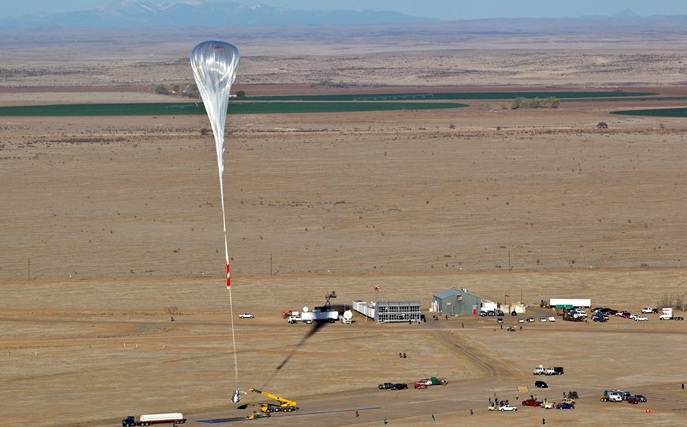 Were you to lay out the tiny polyethylene strips that make up the balloon into a long line, the material would span a staggering 40 acres.Constructed of strips of 'high-performance' polyethylene (plastic) film, it's only 0.0008 inches thick, weighs the equivalent of a full-sized luxury car (3,708 pounds/ 1,682 kg), is nearly 30 million cubic feet in capacity – 10 times larger reportedly than Joe Kittinger's ballon in 1960 – and manages to stretch to a height of a 55-storey building prior to launch. Polyester-fibre tape reinforces the material and offloads the majority of the weight needed to lift the capsule.
Were you to lay out the tiny polyethylene strips that make up the balloon into a long line, the material would span a staggering 40 acres.Constructed of strips of 'high-performance' polyethylene (plastic) film, it's only 0.0008 inches thick, weighs the equivalent of a full-sized luxury car (3,708 pounds/ 1,682 kg), is nearly 30 million cubic feet in capacity – 10 times larger reportedly than Joe Kittinger's ballon in 1960 – and manages to stretch to a height of a 55-storey building prior to launch. Polyester-fibre tape reinforces the material and offloads the majority of the weight needed to lift the capsule.
Looking almost deflated in appearance as the capsule was released yesterday, the helium soon expands as the balloon ascends, filling out into an almost completely round shape at its peak height. Which means the height of the balloon at take-off (a staggering 550 feet) is reduced to around 335 feet at an altitude of 120,000, as the diameter increases ten-fold to a massive 424.37 feet.
The Capsule
And here we come to the spacecraft-sized capsule that housed Baumgartner as he made his way some 120,000 feet above the surface of the Earth. Weighing around 2,900 pounds (1,315 kg), the capsule shell is constructed of a foam-insulated skin covered in fiberglass and paint and is capable of providing both protection and insulation from the near-vacuum just the other side of the acrylic door and windows, standing 11 feet high and 8 feet in diameter. A 2-inch-thick aluminium 'honeycomb sandwich panel' base 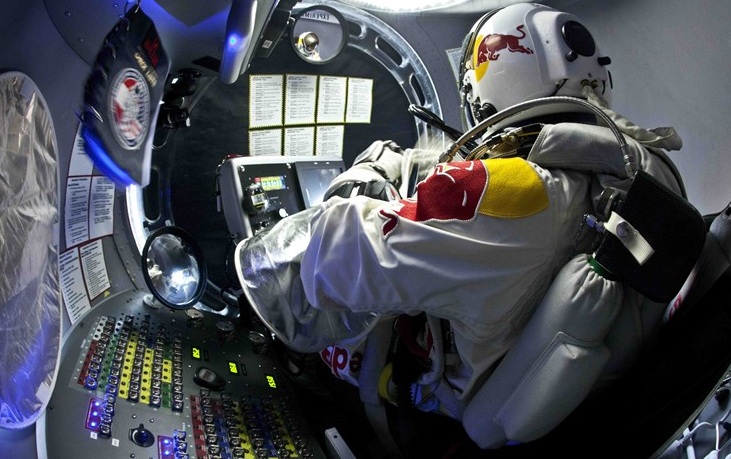 protects the capsule from sharp objects during landing, houses the batteries needed to power the cameras and instrumentation, while crush pads surrounding the base withstand impacts of 8 Gs and provide shock absorption for the capsule's parachute landing – one part of the mission very few of us will bear witness.
protects the capsule from sharp objects during landing, houses the batteries needed to power the cameras and instrumentation, while crush pads surrounding the base withstand impacts of 8 Gs and provide shock absorption for the capsule's parachute landing – one part of the mission very few of us will bear witness.
Inside the capsule itself is a 'pressure sphere', a shell-within-a-shell moulded from fiberglass and epoxy and painted with fireproof paint. The shell houses Felix, the capsule's instruments, displays and camera systems in an atmospheric pressure of around 8 pounds per square inch (psi), the equivalent to 16,000 feet above sea level. A note on the cameras for a second, because nothing was left to chance when it came to missing out on footage of the historic moment – a total of three 4K (4,000 x 2,000-pixel) digital cinematography cameras were used, as well as nine high-definition cameras and three high-resolution digital still cameras. A pressurised electronics “keg” was needed to house some 125 electronic components and approximately two miles of wiring.
Completing the capsule's construction is a cage made from welded Chrome-Moly (chromium molybdenum) aircraft tubing/pipes that surrounds the exterior of the pressure sphere, and is also the point at which the balloon meets the capsule.
The Man
Felix Baumgartner's career is littered with a number of world records and exceptional accomplishments. Born in Salzburg, Austria in 1969, Felix started sky-diving at just 16, before later proving his mettle in the Austrian military's demonstration and competition team. The Stratos mission is just the latest in a long-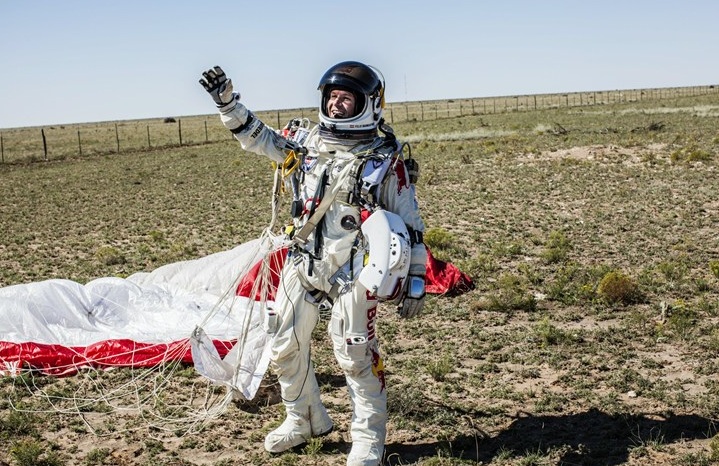 line of collaborations with energy drinks maker Red Bull – it's had him on its books since 1988, where he was originally hired to perform in skydiving exhibitions.
line of collaborations with energy drinks maker Red Bull – it's had him on its books since 1988, where he was originally hired to perform in skydiving exhibitions.
Since picking up numerous highly-commendable awards from agencies around the world, Baumgartner was also the first man to cross the English channel in a wing-suit (it took just eight minutes), and has been on a steady incline to the 'edge of space' his entire life, moving from one extreme jump to the next. From diving into cave systems, and over some extraordinary landscapes, he's gone on to jump from some of the highest natural and man-made locations across the globe.
But as he himself said in a philosophical moment of which Neil Armstrong would be proud; "Sometimes you have to go up really high to realise how small you are."
Richard Birkett
Source: Red Bull Stratos

